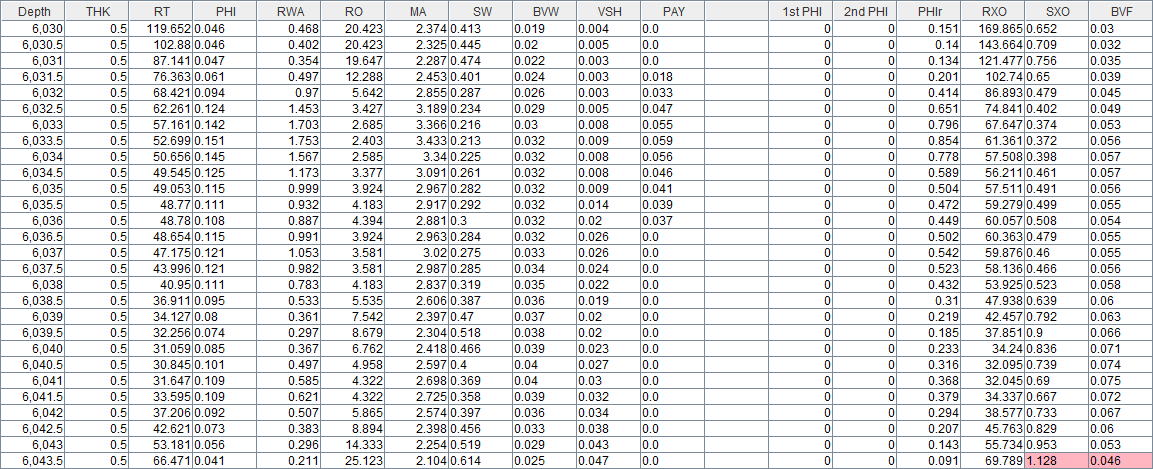

|
HELP: PfEFFER-java |
A single Excel workbook is used to organize all the well log information for a particular well. We will refer to this workbook as a well workbook (even when the well is a dry hole). Each well workbook contains unit worksheets. A unit is a stratigraphic subdivision as defined by a user. So, a unit may be a formal geologic formation, a reservoir interval, or a reservoir subdivision. Logging data may be downloaded for multiple units from LAS File(s), see Importing LAS Files



 |
|
||||||||||||||||||||||||||||||||||||||||||||||||||||||||||||||||||||||||||||||||||||||||||||||||||||||||

| Home Area Columns | ||
|---|---|---|
| Mnemonic | Name | Description |
| RT | True resistivity | Choice of resistivity log to be used is at the discretion of the user. |
| PHI | "True porosity" | PHI must contain fractional (as opposed to percentage) data and is generally equated with "true porosity". At the userís discretion, PHI can be derived from a single porosity log (sonic, density, or neutron) stored in the log columns or computed as a function of several porosity logs. |
| RWA | Reconnaissance (apparent) water resisitivity | Apparent water resistivity for each zone, based on the Archie parameters and the zone porosity (PHI) and resistivity (RT) values. |
| RO | Resistivity of Water Saturated Zone | The resistivity of each zone if it was completely saturated with formation water whose resistivity matched the value recorded in cell Archie parameter RW and a rock with Archie parameters A and M. |
| MA | Apparent Archie cementation exponent | Apparent Archie cementation exponent is calculated under the assumption that the zone is completely water-saturated and that the Archie parameter value RW is the actual formation water resistivity. This computation is a companion technique to the RWA method, but in this case provides a means to estimate the cementation exponent in water zones where formation water resistivity is known, but the Archie equation parameters are poorly known. The values of MA also represent the slopes of an individual water line that result when the zone is located on the Pickett plot and linked with the formation water resistivity intercept. |
| SW | Proportional water saturation | The calculated values of proportional water saturation, using the zone porosity (PHI) and resistivity (RT) value in conjunction with the Archie equation values of a, m, n and Rw |
| BVW | Fractional bulk volume water | Calculation of the fractional bulk volume water in each zone as the product of the fractional porosity and water saturation. As described earlier in this manual, the BVW is often known as the "Buckles number" in reservoir zones at "irreducible" water saturation. The value is controlled primarily by pore size, where large pores cause low Buckles numbers, and small pores are matched by high Buckles numbers. |
| VSH | Fractional proportion of shale | The formula for the VSH column may be set automatically using the Vsh button on the PfEFFER toolbar |
| PAY | Incremental thickness of oil (or gas) | incremental thickness of oil (or gas) in each zone, given by THK*PHI*(1-SW), assuming that the zone satisfies a number of criteria, described below. If a particular zone does not satisfy those criteria, then the PAY entry for that zone is 0, meaning that the zone does not contribute to the net thickness of oil computed in FTOIL |
| 1st PHI | Primary porosity | The primary porosity is determined from the interpolation of the observed bulk transit time between the matrix and fluid transit time extremes, as shown by the formula above. The total porosity column is set equal to column PHI, the porosity in the home area. |
| 2nd PHI | Secondary porosity | Secondary porosity is the total porosity (column PHI) minus the primary porosity determined from the sonic log. |
| PHIr | "Electrically connected porosity" | PHIr (connected porosity) is estimated from resistivity log as the square root of Reconnaissance (apparent) water resisitivity (RWA) divided by the Resistivity of Water Saturation Zone (RO). |
| RXO | Bulk resistivity of flushed zone | Choice of resistivity log to be used is at the discretion of the user. |
| SXO | Saturation of total moveable fluid (assumes filtrate has displaced everything moveable) | The calculated values of saturation of total moveable fluid, using the zone porosity (PHI) and bulk resistivity of flushed zone (Rxo) value in conjunction with the Archie equation values of a, m, n and Rmf |
| BVF | Bulk volume fluid | Calculation of the fractional bulk volume water in each zone as the product of the fractional porosity and saturation of total moveable fluid. Computed as the product of Sxo and PHI. |